Refractive Index Sensor Based on Twisted Tapered Plastic Optical Fibers
Abstract
:1. Introduction
2. Fabrication and Operation Principle
3. Results and Discussion
3.1. Experiment Setup
3.2. Experiment Results and Discussion
4. Conclusions
Author Contributions
Funding
Conflicts of Interest
References
- Zhou, W.; Zhou, Y.; Albert, J. A true fiber optic refractometer. Laser Photonics Rev. 2017, 11, 1600157. [Google Scholar] [CrossRef]
- Zhang, X.; Xie, L.; Zhang, X.; Peng, W. Optimization of long-period grating-based refractive index sensor by bent-fiber interference. Appl. Opt. 2015, 54, 9152–9156. [Google Scholar] [CrossRef] [PubMed]
- John, J.; Bhatia, N. Multimode interference devices with single-mode-multimode-multimode fiber structure. Appl. Opt. 2014, 53, 5179–5186. [Google Scholar]
- Bilro, L.; Alberto, N.; Pinto, J.L.; Nogueira, R. Optical sensors based on plastic fibers. Sensors 2012, 12, 12184–12207. [Google Scholar] [CrossRef] [PubMed]
- Teng, C.; Jing, N.; Yu, F.; Zheng, J. Investigation of a macro-bending tapered plastic optical fiber for refractive index sensing. IEEE Sens. J. 2016, 16, 7521–7525. [Google Scholar] [CrossRef]
- Arrue, J.; Jiménez, F.; Aldabaldetreku, G.; Durana, G.; Zubia, J.; Lomer, M.; Mateo, J. Analysis of the use of tapered graded-index polymer optical fibers for refractive-index sensors. Opt. Express 2008, 16, 16616–16631. [Google Scholar] [PubMed]
- Feng, D.; Liu, G.; Liu, X.; Jiang, M.; Sui, Q. Refractive index sensor based on plastic optical fiber with tapered structure. Appl. Opt. 2014, 53, 2007–2011. [Google Scholar]
- Jing, N.; Zheng, J.; Zhao, X.; Teng, C. Refractive index sensing based on a side-polished macrobending plastic optical fiber. IEEE Sens. J. 2015, 15, 2898–2901. [Google Scholar] [CrossRef]
- Feng, D.; Zhang, M.; Liu, G.; Liu, X.; Jia, D. D-shaped plastic optical fiber sensor for testing refractive index. IEEE Sens. J. 2014, 14, 1673–1676. [Google Scholar]
- Bilro, L.; Alberto, N.J.; Sá, L.M.; Pinto, J.L.; Nogueira, R. Analytical analysis of side-polished plastic optical fiber as curvature and refractive index sensor. J. Lightw. Technol. 2011, 29, 864–870. [Google Scholar] [CrossRef]
- Teng, C.; Yu, F.; Jing, N.; Ding, Y.; Si, Z.; Zheng, J. Investigation of refractive index sensors based on side-polished plastic optical fibers. Opt. Fiber Technol. 2017, 36. [Google Scholar] [CrossRef]
- Shin, J.; Park, J. Plastic optical fiber refractive index sensor employing an in-line submillimeter hole. IEEE Photonics Technol. Lett. 2013, 25, 1882–1884. [Google Scholar] [CrossRef]
- Xin, G.; Peng, K.; Gu, Z.; Zhao, J.; Fan, R.; Liu, L.; Xu, X. Refractive index sensor based on a step index multimode polymer optical fiber with a micro-hole created by a miniature numerical control machine. Chin. Opt. Lett. 2013, 11, 020601–020603. [Google Scholar]
- Liu, G.; Feng, D.; Zhang, M.; Jiang, S.; Ye, Z. Side-hole plastic optical fiber for testing liquid’s refractive index. IEEE Sens. J. 2015, 15, 2902–2905. [Google Scholar] [CrossRef]
- Montero, D.S.; Vázquez, C.; Möllers, I.; Arrúe, J.; Jäger, D. A self-referencing intensity-based polymer optical fiber sensor for liquid detection. Sensors 2009, 9, 6446–6455. [Google Scholar] [CrossRef] [PubMed]
- Bo, L.; Wang, P.; Semenova, Y.; Farrell, G. High Sensitivity Fiber Refractometer Based on an Optical Microfiber Coupler. IEEE Photonics Technol. Lett. 2013, 25, 228–230. [Google Scholar] [CrossRef]
- Liao, C.; Wang, D.; He, X.; Yang, M. Twisted Optical Microfibers for Refractive Index Sensing. IEEE Photonics Technol. Lett. 2011, 23, 848–850. [Google Scholar] [CrossRef]
- Hou, Y.; Liu, W.; Su, S.; Zhang, H.; Zhang, J.; Liu, J.; Xiong, J. Polymer optical fiber twisted macro-bend coupling system for liquid level detection. Opt. Express 2014, 22, 23231–23241. [Google Scholar] [CrossRef] [PubMed]
- Zhu, H.; Wang, Y.; Li, B. Tunable refractive index sensor with ultracompact structure twisted by Poly (trimethylene terephthalate) nanowires. ACS Nano 2009, 3, 3110–3114. [Google Scholar] [CrossRef] [PubMed]
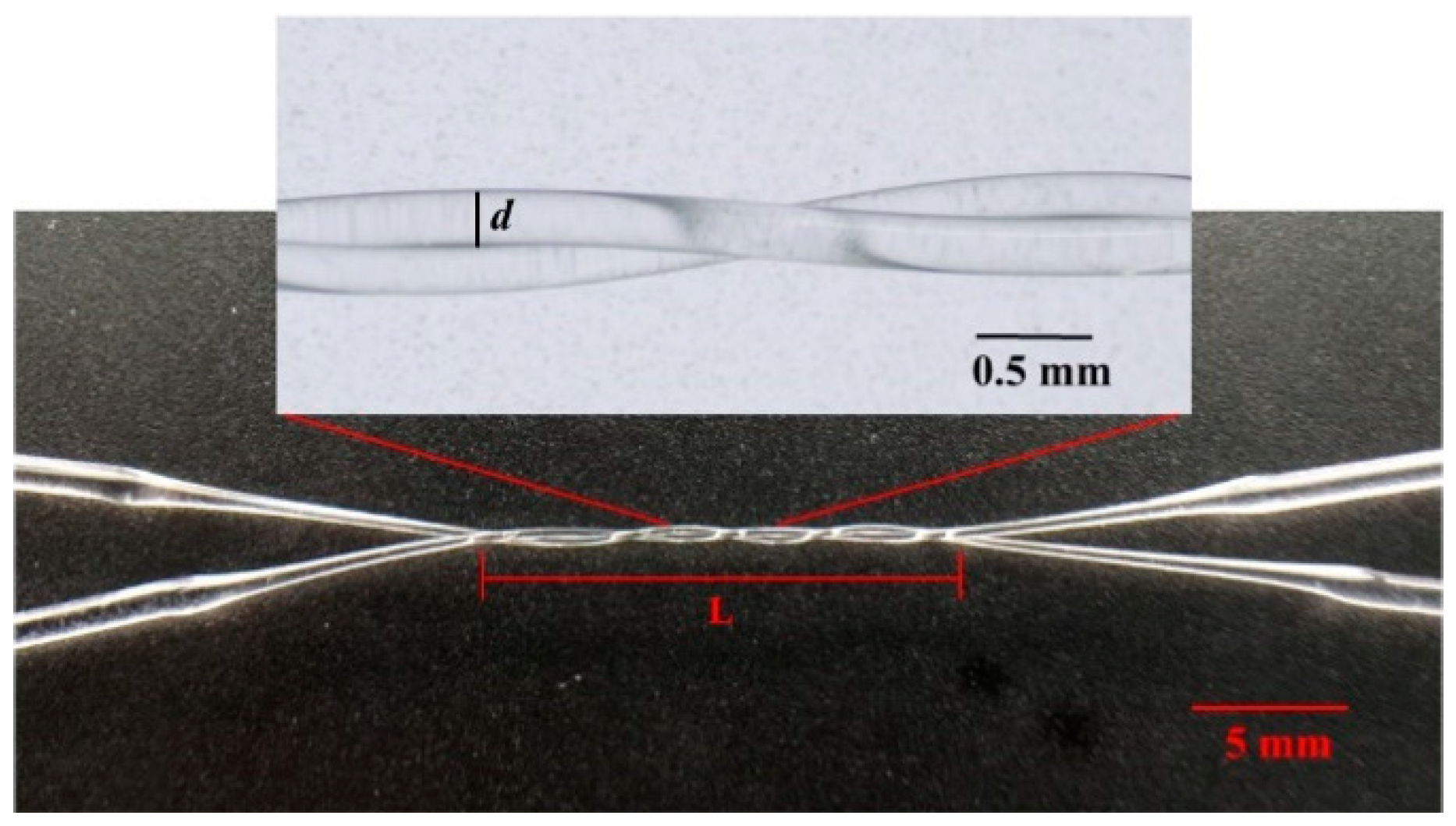
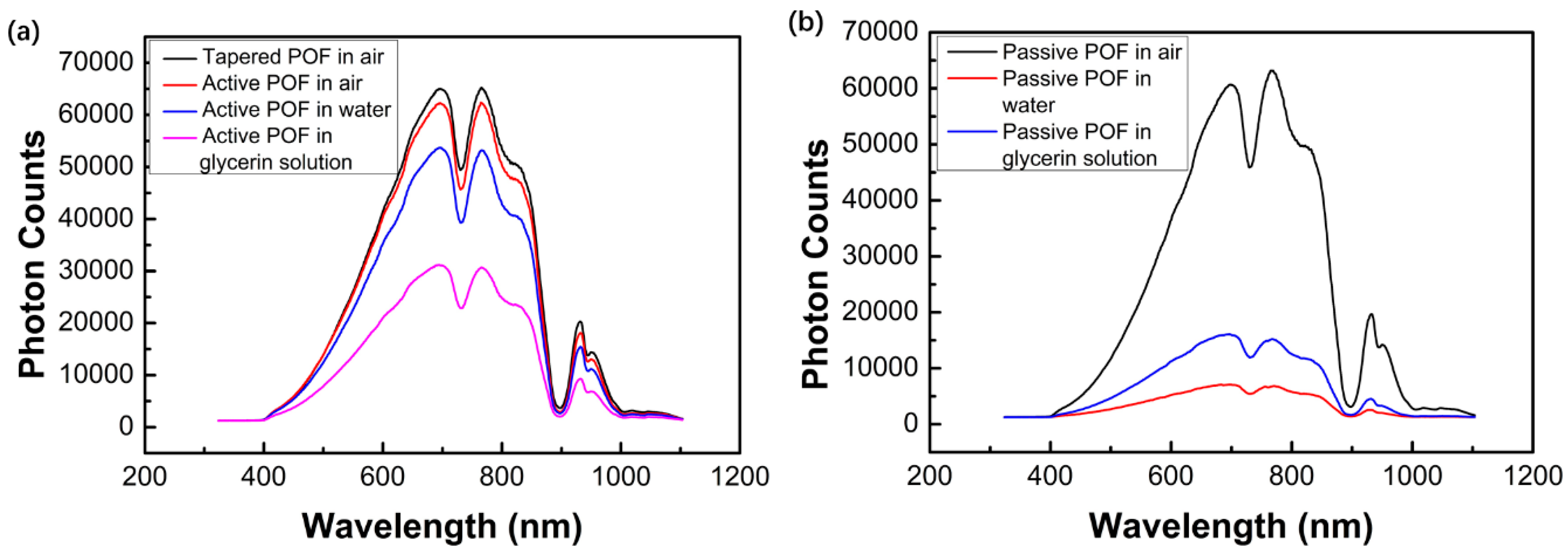
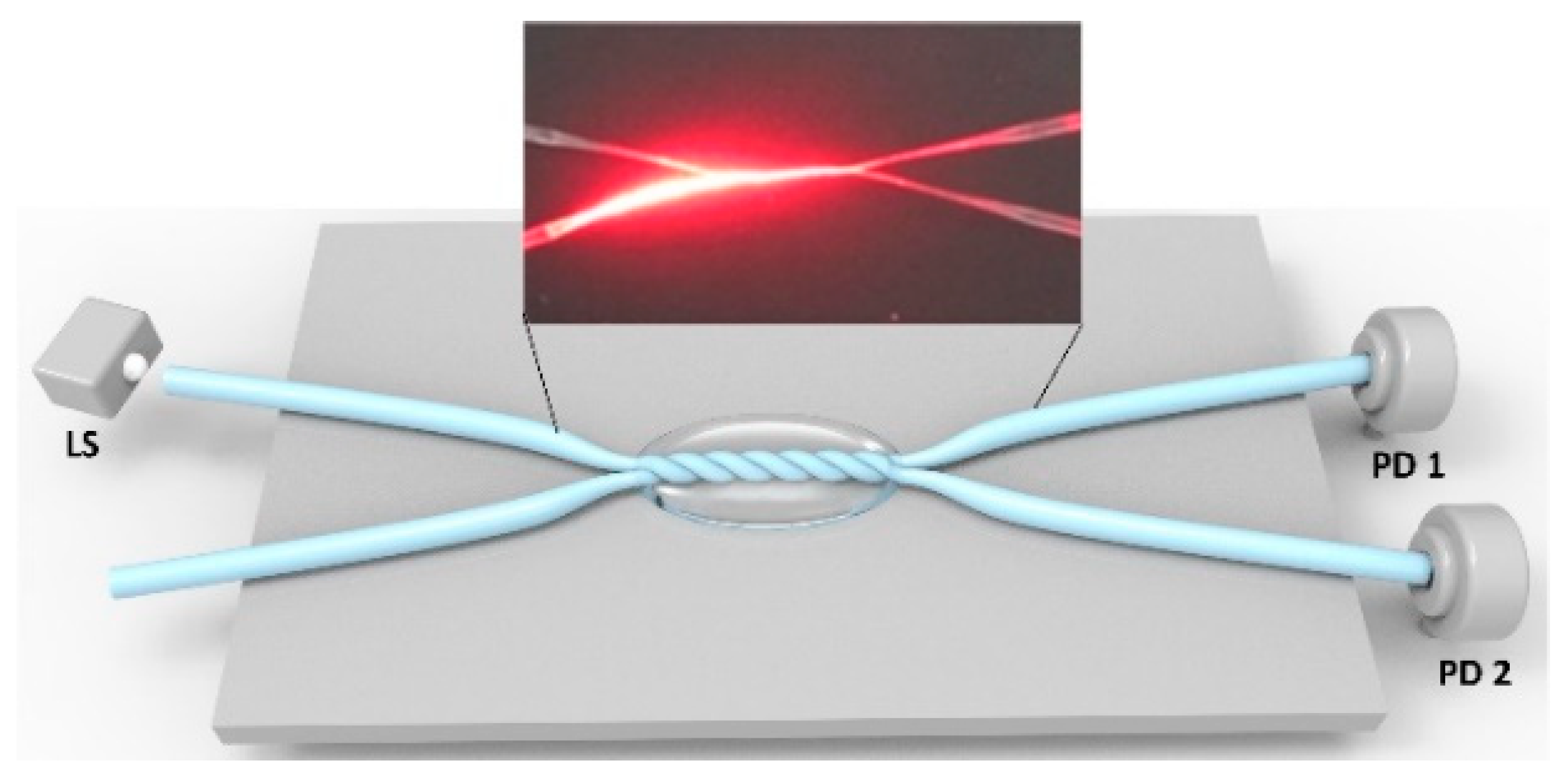
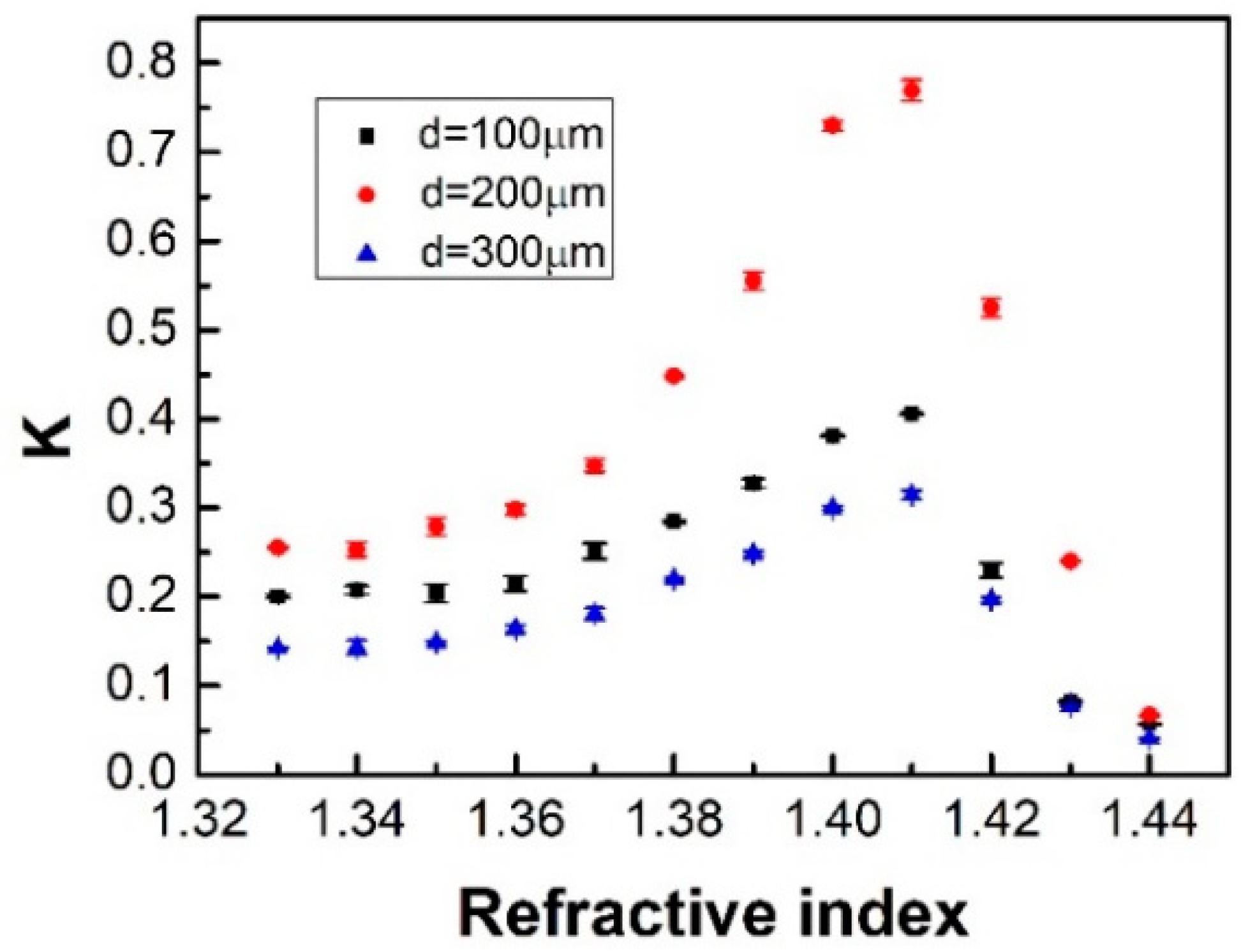
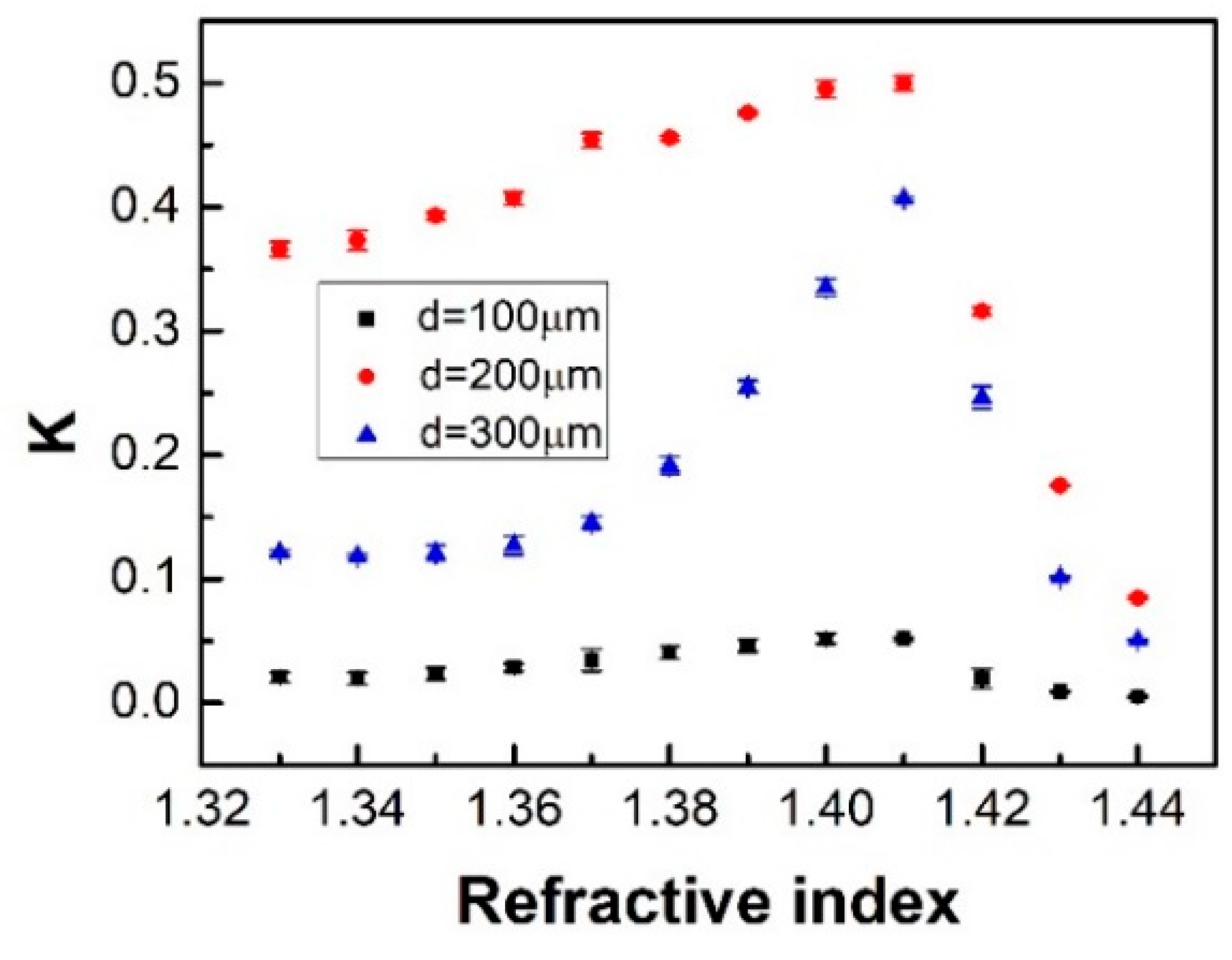
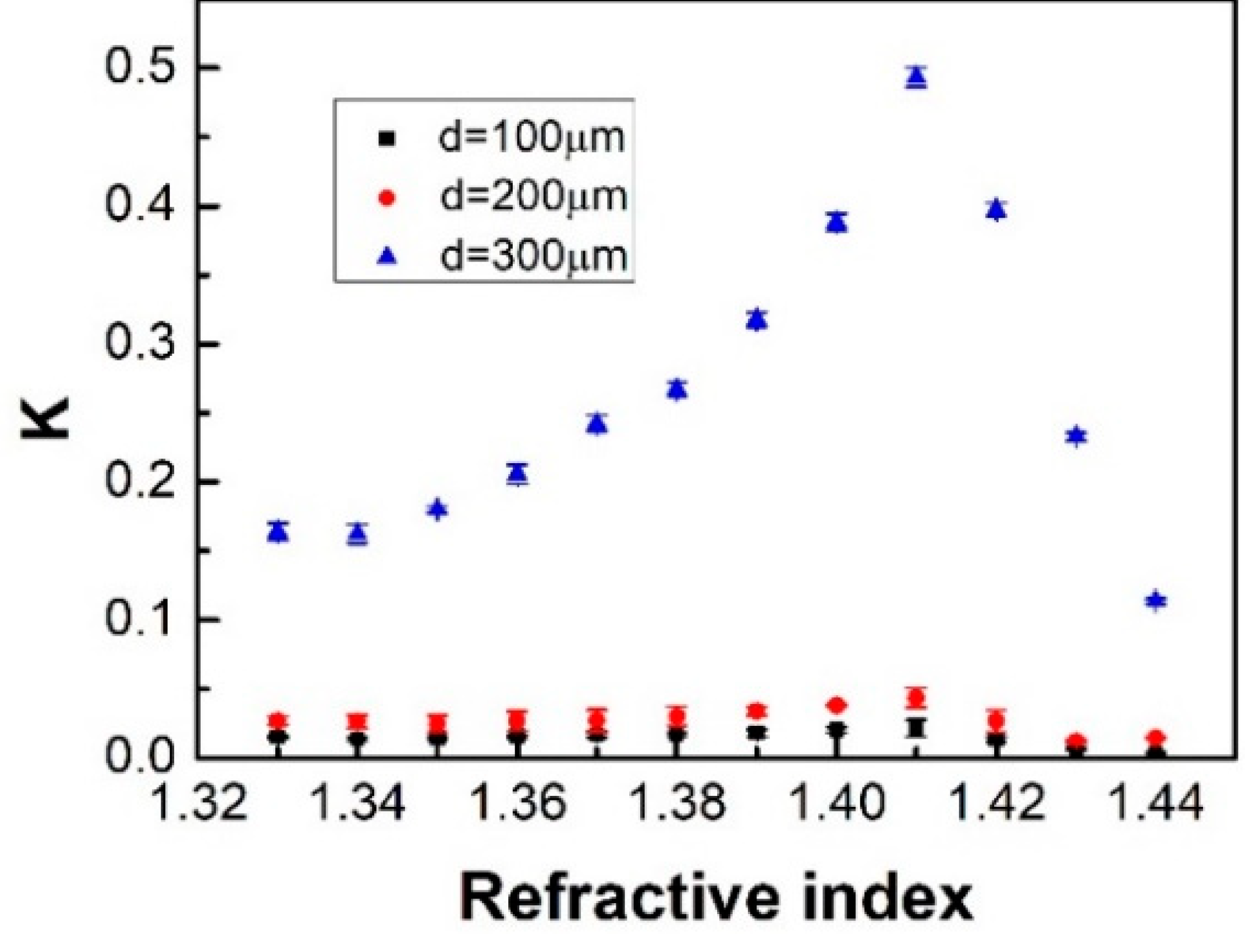
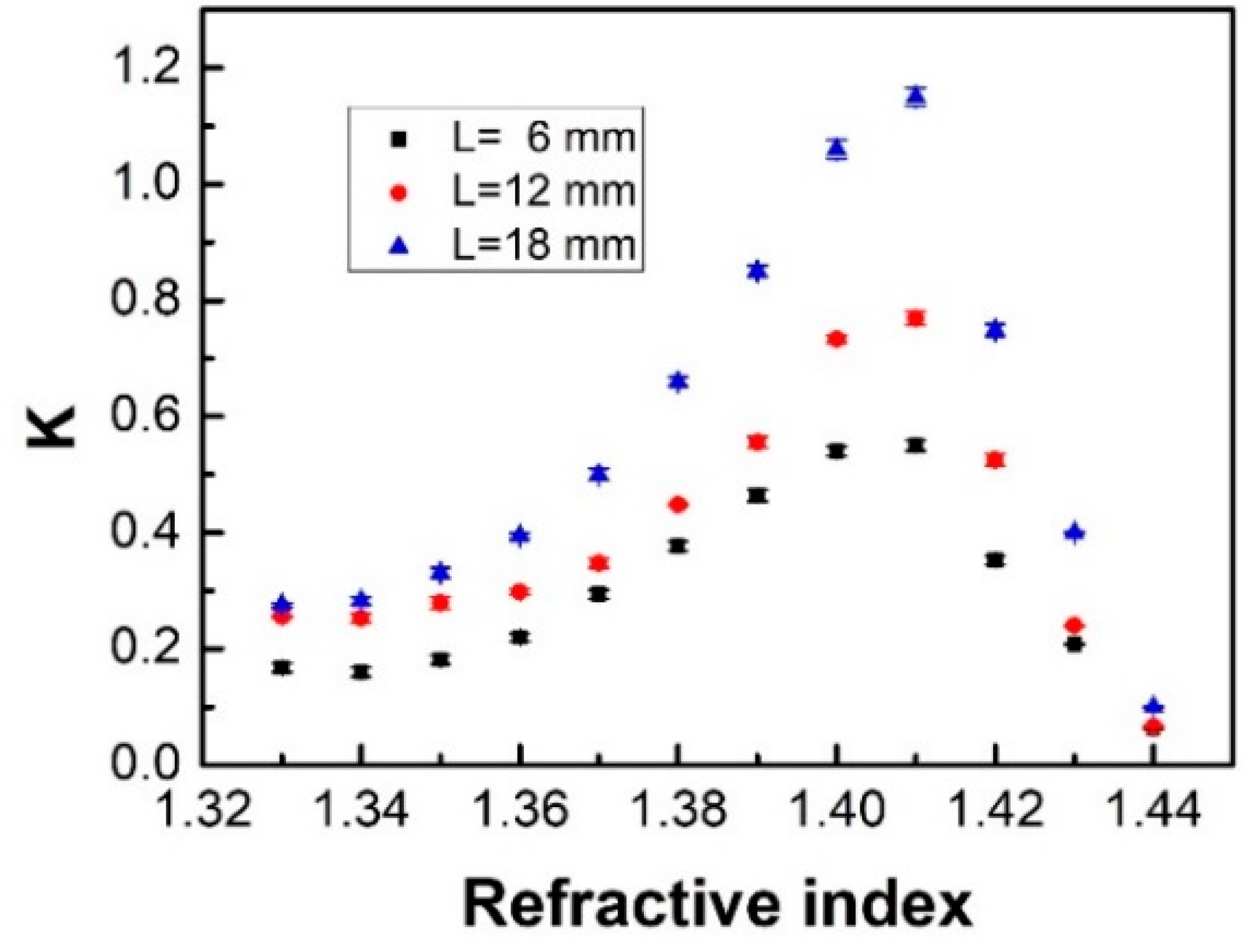
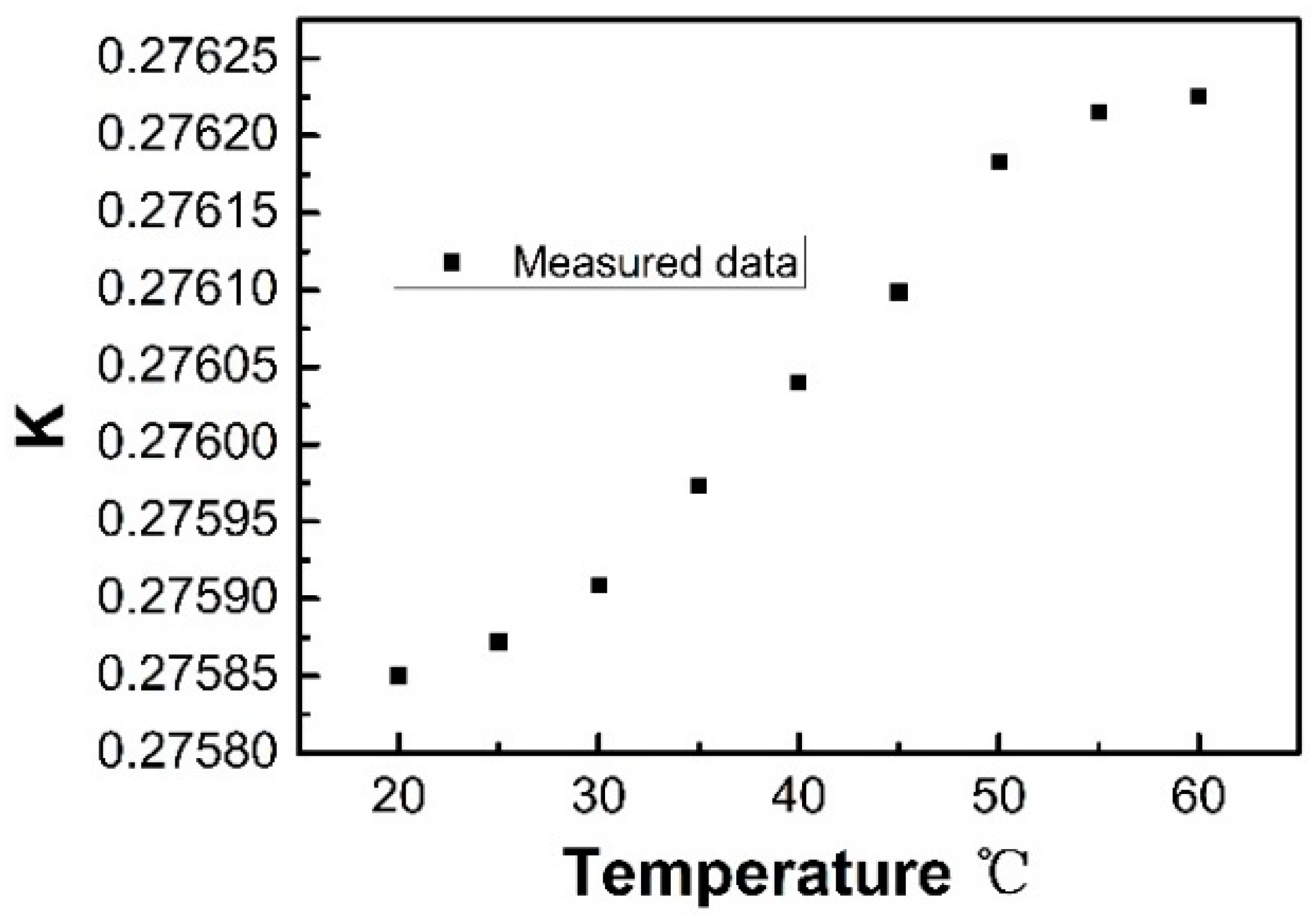
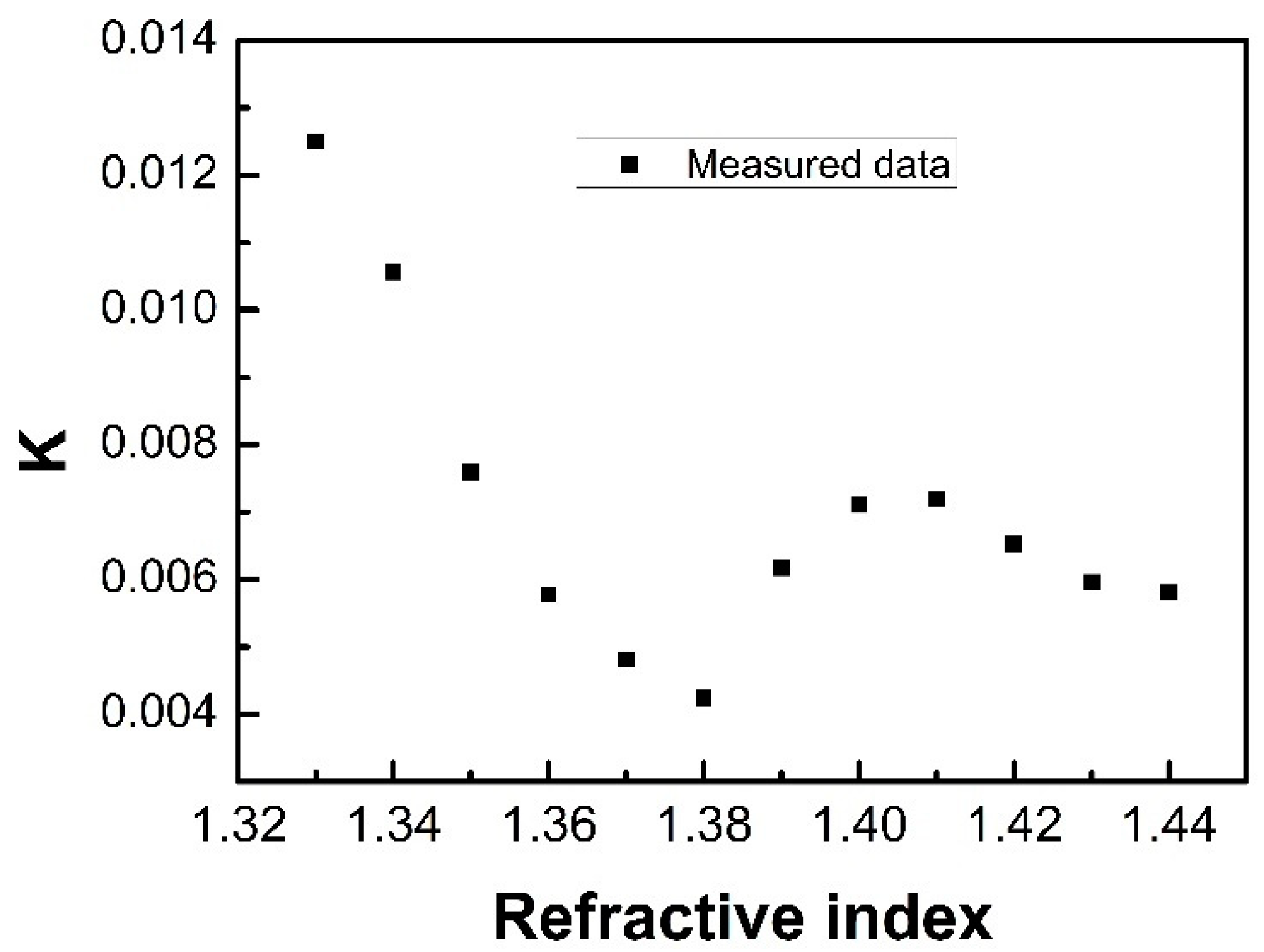
| Passive Fiber Diameter (μm) | 100 | 200 | 300 |
|---|---|---|---|
| Sensitivity (%/RIU) | 406/−1194 | 1125/−2392 | 348/−940 |
| (1.37–1.41/1.41–1.44) | |||
| Correlation Coefficient R2 | 0.9897/0.9209 | 0.9696/0.9916 | 0.9804/0.9563 |
| (1.37–1.41/1.41–1.44) |
| Passive Fiber Diameter (μm) | 100 | 200 | 300 |
|---|---|---|---|
| Sensitivity (%/RIU) | 46/−146 | 131/−1381 | 666/−1214 |
| (1.37–1.41/1.41–1.44) | |||
| Correlation Coefficient R2 | 0.8800/0.8587 | 0.9315/0.9785 | 0.9919/0.9569 |
| (1.37–1.41/1.41–1.44) |
| Passive Fiber Diameter (μm) | 100 | 200 | 300 |
|---|---|---|---|
| Sensitivity (%/RIU) | 13/−60 | 40/−102 | 623/−1303 |
| (1.37–1.41/1.41–1.44) | |||
| Correlation Coefficient R2 | 0.9442/0.9653 | 0.9876/0.8368 | 0.9205/0.9910 |
| (1.37–1.41/1.41–1.44) |
| Twisted Region Length (mm) | 6 | 12 | 18 |
|---|---|---|---|
| Sensitivity (%/RIU) | 676/−1573 | 1125/−2392 | 1700/−3496 |
| (1.37–1.41/1.41–1.44) | |||
| Correlation Coefficient R2 | 0.9291/0.9955 | 0.9696/0.9916 | 0.9880/0.9958 |
| (1.37–1.41/1.41–1.44) |
| Sensor Configuration | RI Sensitivity | Measurement Range | Self-Referencing | Ref. |
|---|---|---|---|---|
| Macrobending | 937%/RIU | 1.33–1.41 | No | [5] |
| Tapered POF | ||||
| Tapered POF | 950 μW/RIU | 1.33–1.41 | No | [7] |
| Side-Polished | 154 dB/RIU | 1.33–1.44 | No | [8] |
| Macrobending POF | ||||
| Side hole POF | 1862.1 µW/RIU | 1.33–1.475 | No | [14] |
| Coupled polished | Not mentioned | Not mentioned | Yes | [15] |
| POF | ||||
| Twisted nanowires | 26.96 mW/RIU | 1.332–1.354 | No | [19] |
| Twisted | 1700%/RIU/ | 1.37–1.41/ | Yes | This work |
| tapered POF | 3496%/RIU | 1.41–1.44 |
© 2019 by the authors. Licensee MDPI, Basel, Switzerland. This article is an open access article distributed under the terms and conditions of the Creative Commons Attribution (CC BY) license (http://creativecommons.org/licenses/by/4.0/).
Share and Cite
Teng, C.; Deng, H.; Liu, H.; Yang, H.; Yuan, L.; Zheng, J.; Deng, S. Refractive Index Sensor Based on Twisted Tapered Plastic Optical Fibers. Photonics 2019, 6, 40. https://doi.org/10.3390/photonics6020040
Teng C, Deng H, Liu H, Yang H, Yuan L, Zheng J, Deng S. Refractive Index Sensor Based on Twisted Tapered Plastic Optical Fibers. Photonics. 2019; 6(2):40. https://doi.org/10.3390/photonics6020040
Chicago/Turabian StyleTeng, Chuanxin, Hongchang Deng, Houquan Liu, Hongyan Yang, Libo Yuan, Jie Zheng, and Shijie Deng. 2019. "Refractive Index Sensor Based on Twisted Tapered Plastic Optical Fibers" Photonics 6, no. 2: 40. https://doi.org/10.3390/photonics6020040
APA StyleTeng, C., Deng, H., Liu, H., Yang, H., Yuan, L., Zheng, J., & Deng, S. (2019). Refractive Index Sensor Based on Twisted Tapered Plastic Optical Fibers. Photonics, 6(2), 40. https://doi.org/10.3390/photonics6020040






